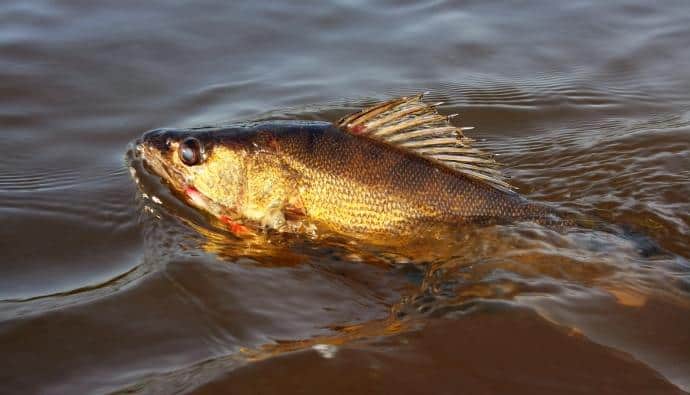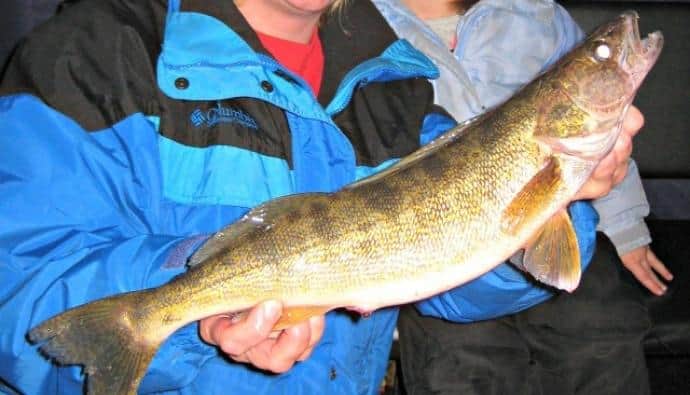With jagged teeth, bug eyes, and elusive nature, walleye are some of the most fun fish to pursue. Quite possibly the best tasting freshwater fish in North America, these predators are some of the most challenging fish to angle for.
Unlike bass, musky, or pike, they don’t often reach a fantastical size and are not known for being the most aggressive fighters.
However, because of their flavor profile and the thrill of the chase, walleye or a highly sought-after aquatic commodity, and while there is a multitude of ways to angle for walleye, one of the most effective is trolling.
In this article, we’re sharing everything you need to know on how to troll for walleye.

What is Trolling?
Performed from the boat, trolling at its simplest is when baited rigs or lures or run behind a boat in motion, towed at a slow speed enough for a fish to take a bite.
Why Troll for Walleye?
Walleye’s eyes work well in turbid and deep water. Because of this, they can often be found inhabiting a body of water in deeper regions. Because they are primarily sighted predators, they are attracted to movement and flashy colors.
However, they avoid direct exposure to the sun as often as possible due to its bright light and prefer to dine in as low of light level conditions as their eyes will allow.
Because trolling covers a vast amount of water in a short period, provides choppy waters in which flashy lures that move exist, and allows anglers to fish multiple levels of the water column at once, it gives the ideal setup when angling for walleye.
What Do You Need?
To troll for walleye, there are a couple of essential items that are a must-have.
- Boat
- Rod
- Reel
- Lures
- (Optional) Fishfinder
The first of these is a boat. Preferably, the craft in question has rod holders towards the vessel’s rear.
In an ideal scenario, these rod holders would be situated with an adequate distance of over a foot between them to prevent entanglement.
The next piece of equipment is fishing rods. Fiberglass or graphite rods that are 6 to 9 feet in length with a moderate action work best.
A rod with medium to heavy power will provide plenty of the backbone necessary while still allowing for a significant amount of flexibility at the upper half of the rod.
This provides cushioning to counteract the strain placed by planter boards which tug on the rod tip when in rough water.
Depending on the boat’s setup, the most extended rods, and anglers should be placed at the outermost edges of the boat. Conversely, the shortest rods should be placed closer to the center.
Following the rod is the reel. To maximize the effectiveness of the setup, line counting reels are necessary.
Line counting reels can be summarized as round small bait casters with a line counting mechanism that attaches to the spool, providing information on how much line has been released from the spool.
Line counters play an essential role as they provide the angle with the ability to determine what level of water column they wish to fish.
Then, the angler can correct course, feeding out or reeling in the right amount of line. This combination can be deadly when used in conjunction with a depth chart and a fish finder.
Finally, lures are critical to ensuring success when trolling for walleye. While there is a wide variety available to choose from, it is best to stick to baits anglers are familiar with. Most often on hand are crank or stick baits.
If using these kinds of bait, anglers must match the hatch. This means they take stock of available food sources for walleye and then select a kindred lure in color, shape, and size.
Depending on water conditions, bait with a more natural color will work better in more transparent water, whereas brightly colored lures work best in cloudy or stained water.
Because trolling involves covering a vast swath of area in search of walleye, a fish-finder can be incredibly helpful.
While walleye are predatory fish, they often attempt to find food sources and stick near them. With a fish-finder, when an angler finds the sheep, the wolves are sure to be lurking somewhere close by.
How to Troll for Walleye?
Once the necessary gear has been obtained and the setup constructed, anglers are ready to hit the water.
When trolling, it’s best if anglers go with a partner. This allows for more hands available to deal with netting, reeling, and moving lines for other obstructions out of the way.
For beginners, it’s best to start with as few lines as possible in the water. This helps prevent entanglement and allows newbie anglers to focus more on the rod tips to watch for action.
Incorporate the fishfinder into the game plan. Utilizing this device to determine depth, congregations or schools of fish, and underwater terrain will greatly benefit anglers.
Helpful Tips
Find the Bait
Whether it’s a crankbait or a soft plastic worm, knowing where the walleye’s prey is will only enhance anglers’ ability to catch their quarry.
Once the bait is found, anglers should try different lures. If anglers are unsure what the walleye are biting on that day, utilize any and every lure available. Also, purchase a couple of extras… anglers are bound to lose a few lures to snags or sharp-toothed predators.
Once something begins working, it’s most likely a bait common in the ecosystem. Throw that lure again and stick with it, including incorporating it onto the other rod tackle.
Change Speed
When trolling, anglers often miss the sweet spot in speed. Like Goldilocks with Yamaha horsepower, some go out too hot and some too slow. Lure speeds can make all the difference in getting a bite.
The average trolling speed sits between 1.5-3 mph, so play with both ends of the spectrum to determine which is yielding the most success.
Check the Shallows
While the common perception of walleye habitat is often deeper, darker, and more turbulent water, it is not uncommon to find walleye in the shallows.
Because they are predatory creatures, they will chase the bait into anything from creeks, bars or reefs, or sandy shallows.
Look for structure or prime ambush locations where a walleye could be lurking and trolling past it.
The walleye can be an elusive catch; trolling for them can yield both a full icebox and a good time. With the proper tackle and gear, anglers should look to their fish finders to capitalize on locations that may be rich with bait.
Trial and error is a great teacher; finding a lure that matches the surroundings will yield an initial step in the right direction.
Finally, variance is critical. Constantly tweaking the speed of the troll, lures, and location constitutes a better chance of a successful fishing trip. As always, good luck and stay safe on the water.

 Facebook
Facebook YouTube
YouTube








